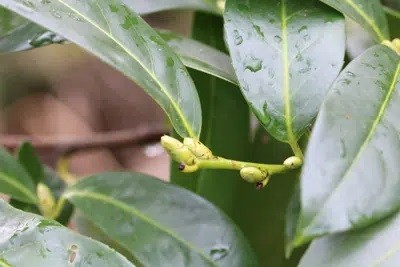The cherry laurel or, as it is botanically correctly called, the laurel cherry (bot. Prunus laurocerasus) is a popular hedge and specimen plant that has found its way into many gardens. The main reason for this is its strong growth, which in a few years leads to high and dense privacy hedges. By cutting off the blossoms that appear in spring, many a gardener tries to increase the growth rate of the cherry laurel. Does this actually make sense?
Contents
Cut off cherry laurel flowers – useful?
Between May and June, the bay cherry shows its sweet-smelling flower decoration, which consists of numerous creamy-white flower clusters and is a valuable food source for insects. By autumn, the berries develop from them, first red and later black when ripe. Since the formation of the flowering glory of the plant takes a lot of strength and energy, which is at the expense of shoot growth, many a gardener simply cuts them off, hoping for better growth. However, capping flowering shoots is tedious (and can only be done mechanically with the help of loppers – which, depending on the size and length of the hedge, takes a lot of time) and is timed very close to the recommended second hedge pruning, which should be done around St. John’s Day on June 24 anyway.
Tip: During early summer pruning, shorten all new shoots to such an extent that the cherry laurel is subsequently stimulated to grow more densely. This measure is especially indicated for young plants; older and well-rooted specimens are pruned primarily in March and/or October
Cut away faded flowers
Although cutting away the blossoms is not very useful (and often does not show the desired success), the blossoms can be removed in the course of the due pruning. This has the advantage that the poisonous berries cannot develop and thus no longer pose a danger to small children. On the other hand, completely different factors have a much greater influence on the growth of the bay cherry, as the following sections show. Insofar as you want to accelerate the vigor of your Prunus laurocerasus hedge, you need to pull other levers.
Rapid growth
An average laurel cherry grows up to 50 centimeters in height and another 35 centimeters in width per year. Depending on the species and variety, the woody plant reaches growth heights of up to six meters and can grow up to three meters wide – so it’s no wonder that the evergreen cherry laurel is particularly popular for designing dense privacy hedges. However, the growth is not always equally strong and some specimens do not seem to develop like. There are several reasons for this, all of which influence the extent and speed of growth:
- Location
- Soil composition
- Weather conditions
- Care measures (water, fertilization)
If the hedge is in a location that is not very suitable for the bay cherry – for example, in a heavy, poorly drained soil – the shrub will grow very little. The same is true if the plant suffers from a lack of nutrients. So before you try to boost growth by removing the clusters of flowers that appear in May, you should first find out the real cause of the reduced growth and eliminate it. Otherwise, you will deprive yourself of the flower decoration completely unnecessarily, since cutting off the flowers from the cherry laurel will have no effect on the rate of growth.
Proliferation of different species of cherry laurels
Apart from the influence of external factors on the growth of Prunus laurocerasus, a lower or higher degree may be due to the selected species and variety. Different species of cherry laurel grow at different rates and reach very different heights. Therefore, if your hedge is also noticeably slow, this could also be due to the variety:

- ‘Diana’: annual growth of up to 50 cm, growth height up to three meters.
- ‘Greentorch’: annual growth up to 30 cm, growth height up to 250 cm
- ‘Herbergii’: annual growth up to 40 cm, growth height up to 250 cm
- ‘Hibani’: annual growth of up to 40 cm, growth height up to three meters
- ‘Mano’: slow-growing, low-growing cultivar, annual growth maximum 20 cm, growth height up to 150 cm
- ‘Mount Vernon’: slow growing ground cover, annual growth between five and 15 cm, maximum growth height 40 cm
- ‘Otto Luyken’: annual growth of up to 40 cm, growth height up to 150 cm
- ‘Piri’: slow growing dwarf form, annual growth between five and 15 cm, growth height up to 100 cm
- ‘Reynvaanii’: annual growth of up to 40 cm, growth height up to three meters
- ‘Rotundifolia’: annual growth of up to 40 cm, growth height up to four meters
- ‘Schipkaensis Macrophylla’: annual growth of up to 50 cm, growth height up to three meters
Tip: Fertilize the cherry laurel with plenty of compost and horn shavings as soon as you plant it, and you should also water it vigorously afterwards. Older plants receive a nitrogen-rich slow-release fertilizer at the beginning of the season and are watered as needed. Well supplied in this way, you create the best conditions for rapid and healthy growth


